Fill three bottles with increasing amount of water.
Label them 1 -2 -3.

Sounds That Talk
Form groups and have players talk about sounds that tell them something.
• Horns on cars and trucks warn____________________________.
• Tea kettles whistle to let us know__________________________.
• The ringer on a telephone or doorbell tells us________________.
• Smoke alarms go off when________________________________.




SHARE THIS PAGE!